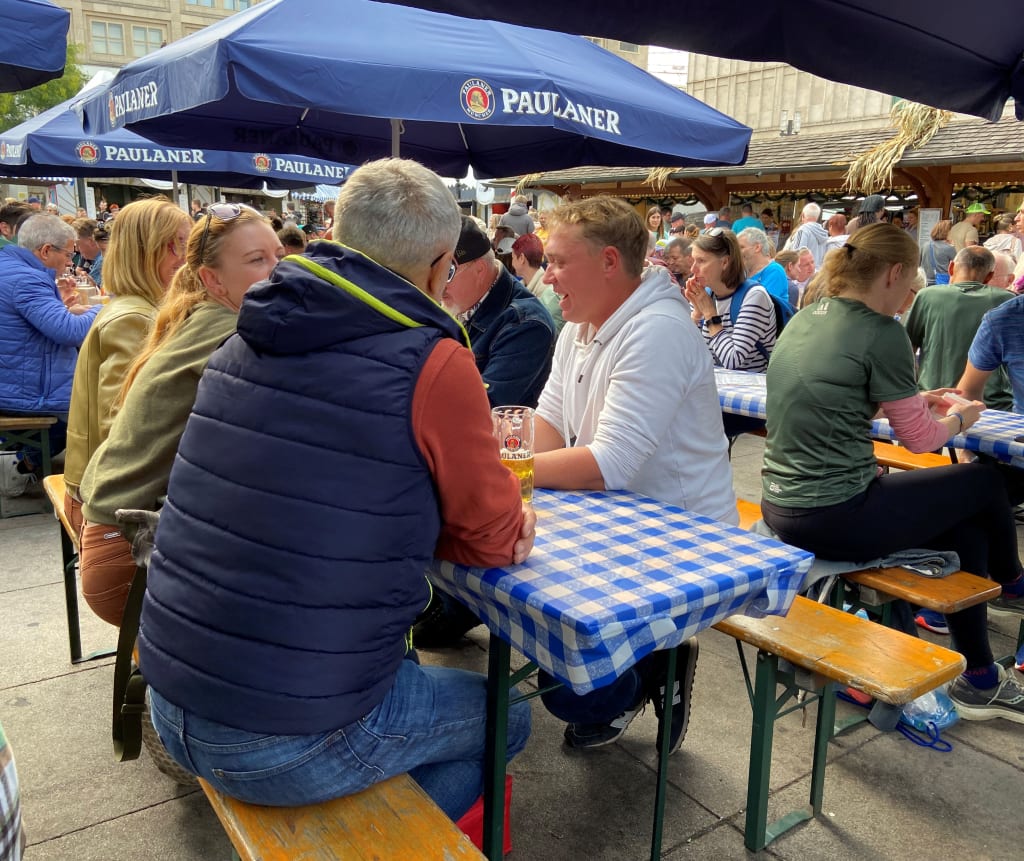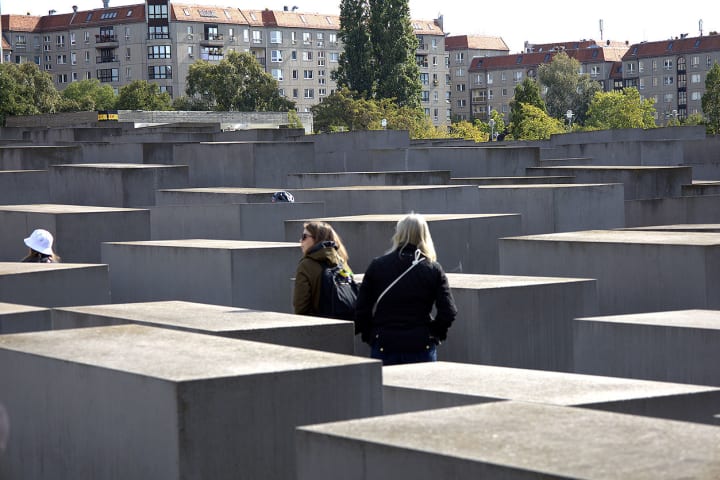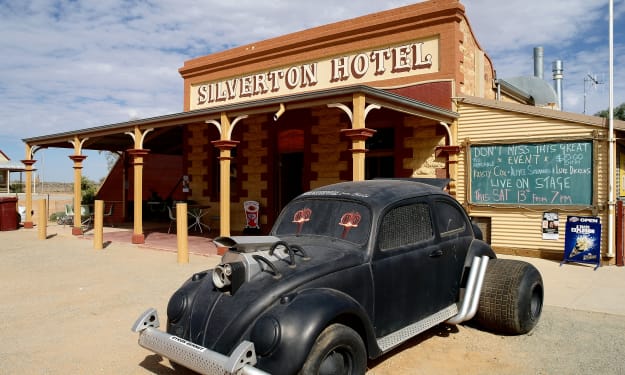The Many Faces of Berlin
The past meets the future in Germany's capital city

Octoberfest is party time in Berlin and I just couldn’t get into it. I was sharing a long table with the locals in Alexander Platz, a huge outdoor plaza in the middle of the city while nursing a lager, four euros for the drink and another for the glass stein which I get back after returning it to the bar. The Germans are nothing if not practical.
The stage band asked the crowd to join them in a raucous, up-tempo singalong. My table mates heartily complied. They were having a great time. I’m sure the whole city was having a great time but I was conscious of a heavy undercurrent. I sensed ghosts and the heavy hand of history and the realization this place had been a war zone. World War II. Soviet occupation. The Wall. Checkpoint Charlie. Even this place, happy Alexander Platz, used to be a staging area for Soviet troops immediately after the Second World War when Berlin, like the rest of Germany, was split into East and West until reunification in 1990.
Don’t get me wrong. The city has done an admirable job of acknowledging the mistakes of the past. The Fuhrerbunker, a reproduction of Hitler’s subterranean hideout - the original has been paved over – presents an unfiltered account of Hitler’s rise to power and Germany’s march to war. It’s only one of many reminders.
The Jewish Holocaust Memorial is another, a maze of concrete blocks across the street from the former Luftwaffe headquarters and now the home to the German Finance Ministry. It dips in the middle and as I walked towards the center, I felt dread and oppression, just like the Reich’s many victims experienced, I’m sure, as I imagined the columns closing in on me. The Memorial is intended as a place of reflection and it works.

The Reichstag, once again the seat of the German Parliament, sports a new glass dome overlooking the Spree River and a collection of parks, cafes, and new office buildings which now line its shores. The iconic Brandenburg Gate is once again Berlin’s prime people place, the site everyone flocks to for concerts, events and yes, protests. Berlin has done a fantastic job of rebranding

Expunging 46 years of a Soviet presence hasn’t been as easy. The moment I crossed into former East Berlin the change was unmistakable. Karl-Marx Allee, the sector’s main road was built in 1952 with May Day parades in mind, as in a parade of tanks. Café Moskau, a former East Berlin hangout and now a meeting center with offices for rent, still sports a mock Sputnik on its roof and the Berlin Tower, a communications tower erected in 1969 by the Soviets is still the highest vantage point in the city.
Other Cold War landmarks include the disappointingly kitschy Checkpoint Charlie. Moved from its original location to a busy intersection to satisfy the tourist trade it’s nothing more than a photo op as visitors scurry behind sandbags to get their picture taken. Yep, I confess, me too as I jostled for a selfie. I rested at nearby Charlies Beach, a bizarre urban food bar complete with beach sand and deck chairs and gobbled my kebab next to a chunk of the Berlin Wall.
Make no mistake, the Wall and its impact on the city is still a fresh wound. Over 140 Berliners died trying to get over the Wall and escape to the West. Their names and photos are on display in the Tiergarten next to the Brandenburg Gate.
The East Side Gallery is another reminder of Soviet incursion. When it was first erected in 1961 angry Berliners expressed their outrage with slogans and graffiti. When the Wall came down in 1991 some of those painted sections were relocated to Muhlenstrade, beside the Spree, and the original artists invited to recreate their iconic works. The result is a blaze of color and protest. It’s the longest open-air gallery in the world. East German leader Erich Honecker kissing Soviet boss Leonid Brezhnev on the mouth is the most famous and most photographed of the lot.

There are 170 museums in Berlin. I didn’t make it to all 170, surprise, surprise, but my favorite was German Museum of Technology, a sprawling collection of planes, boats, cars and in a nearby train shed, mid-century locomotives and coaches. I’m not a gearhead but the Technikmuseum is the most comprehensive transportation collection I’ve ever seen. It also documents the evolution of computers, radio and printing. You can’t miss it; a plane hangs from the roof.
That’s not to say Berlin is all about learning and history. The Tiergarten, Berlin’s own Central Park with 210 kilometers of hiking trails, a zoo, and an aquarium smack dab in the middle of the city, was a welcome respite from sightseeing. Nearby Spreebogenpark with its wide lawns and waterfront promenade was another perfect place to stop, sit, and watch the Spree and assorted water craft move by. To top it all off, the city boasts 620 kilometers of bike path and trails.
And the food? I ate well. My Airbnb happened to be kitty corner to Zur Letzten Instanz the oldest restaurant in Berlin. I swear the menu hasn’t changed since1621. I dined on pork knuckle, potatoes and red cabbage and washed it down with a refreshing pilsner. Back in the 1960’s, West Germany was second only to the United States in beer production, it’s fallen off now, but not to worry, there are still plenty of suds around.
The next day, the city hosted the Berlin Marathon. Streets were closed, barriers were put up and audience vantage points were determined. The streets crackled with excitement as the city came alive with thousands of tourists and one of the world’s premier sporting events.
Afterwards, I retreated to my favorite coffee shop Berliner Kaffeerosterei and took stock on what I had seen. I no longer felt constrained by the heavy hand of history but energized by it. I appreciated how Berlin capitalized upon its history but I also marveled at how Berlin has moved on.
Berlin is a modern, tech savvy town, the home of enterprises like Futurium, a public interactive space devoted to imagining future communities, private companies such as Berlin Space Technologies which makes satellites and the Technical University of Berlin which turns out those folks that make the satellites. Turning Potsdamer Platz, another former East Berlin plaza into an ultra-modern shopping center is impressive as are the high-end shops along Kurfustendam. They all scream modernity.
“Ich bi ein Berliner,” President Kennedy said to his German hosts in 1963 at the height of the Cold War. He praised Berliners on their resilience and commitment to democracy, correctly predicting that Berlin would re-emerge as a unified and important capital city. He was right.
“I am a Berliner,” he proclaimed. Me too, Mr. President, I thought to myself while overlooking the ever-changing face of modern Berlin.
About the Creator
John Thomson
Former television news and current affairs producer now turned writer. Thanks Spell Check. Visit my web page at https://woodfall.journoportfolio.com






Comments
There are no comments for this story
Be the first to respond and start the conversation.